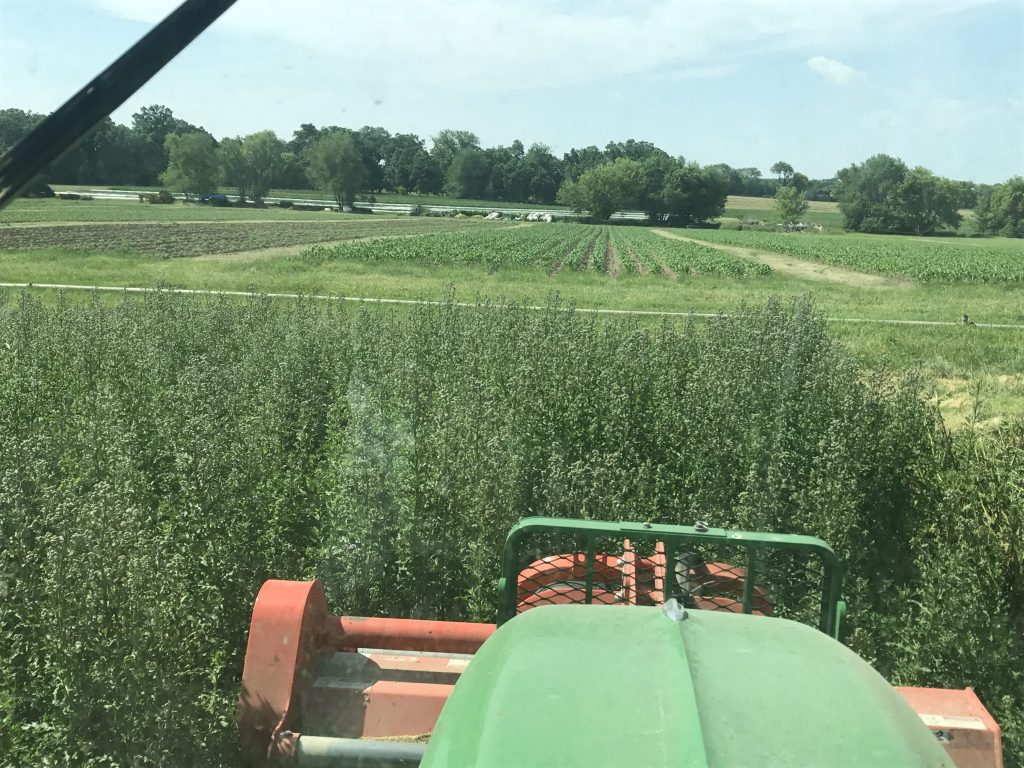Farmer John Writes: On Weather and Weeds
Week 2, June 20-24
For those of you receiving your first share this week, welcome to our 27th season as a CSA farm!
Your Box This Week – Saturday Deliveries:
Salad Greens — Lettuce
Cooking Greens — Baby chard (in bag), kale, pac choi
Brassicas — Broccoli
Fruiting Crops — Zucchini
Alliums — Scallions, Garlic scapes
Herbs — Basil
More on Weather
Last week I wrote about this week’s spinach, or rather, absence of spinach: For sure, the boxes for the second week will receive no spinach. This would have been the result of seeding it and having it go to waste in the heat, if I had seeded it; instead, it is the result of not seeding the spinach at all. If you missed that issue, Soil Rocks, check it out here.
I was hoping that there would at least be spinach in all of the Week 1 shares, but the 90 degree heat scorched the spinach that was scheduled for the end-of-week deliveries, so we didn’t give it.
Last week’s high temperatures were also hard on the broccoli. It made some of the broccoli heads start to separate before they were mature. Most of the broccoli is harvestable, but some of what we harvested is not gorgeous. The broccoli that is now beginning to form heads will likely do better, as the weather has cooled considerably. Growing broccoli here in the spring is a risk; it usually provides a lovely harvest, but sometimes a heat wave degrades it.

Broccoli
Weeds, Especially Thistles
Many people in this age of striving for equality prefer to co-exist with weeds, or at least prefer for their farmer to co-exist with weeds. I don’t take kindly to weeds. I have probably 12 machines for fighting weeds, plus 20 or so hoes, plus tillage and rotational methods for vanquishing weeds. If we didn’t relentlessly fight weeds here, your CSA box would probably be 1/3 to 2/3 full on the more bountiful weeks. On the less bountiful weeks, your box would arrive empty.
There are theoreticians who claim that weeds will not flourish in balanced soil. My fertility consultants say that, based on soil tests, our soil is beautifully balanced. Yet, we have weeds. We have one weed in particular that has been a nuisance for agriculture for generations—the prickly Canadian thistle.
When I was little, my sisters, Mom and I would head for the fields to cut the flowering heads off of Canadian thistles that were populating our oat fields and our pastures. When I was older, a friend cut thistle flowers and arranged them into a bouquet for the farmhouse. My mother said, “You have to be kidding. Do you know what those are? Those are thistles! I started hoeing thistles out of corn when I was 5—it didn’t matter how hot it was—we had to control the thistles!” (Those of you who knew my mother can hear her saying it.)
Canadian thistle is against the law in Illinois…yes, against the law. This county (Boone) used to have a weed commissioner. If the weed commissioner decided you had too many thistles in your fields, he would order you to control them. If you didn’t comply, he would send someone in to spray them.
Part of why herbicides became so popular so quickly was that they offered a way to easily control thistles. The first effective herbicide control for thistles was 245T, which has quite a close relationship with the defoliator Agent Orange, used extensively in scorched-earth campaigns during the Viet Nam war.
Pretty much any internet search for Canadian thistle control will reference herbicides, but we use only certified organic practices at Angelic Organics, so we have a limited arsenal for controlling thistles.
Here’s an excerpt from the internet on Canadian thistle. (I have bolded the text that highlights the challenge of thistle control.):”Creeping [thistle] roots provide stored food and numerous underground buds to depths well below the plow layer. Removal of shoots and severe damage to established plants stimulate new growth from underground buds. It is the buds on the creeping roots of established Canada thistle plants which largely account for re-establishment after attempts at control. Buds on creeping roots can generate new shoots a year or more after top-growth has been destroyed. Seed is produced when patches with male flowers are in close proximity to patches with female flowers. While young seedlings are not competitive in most crops, they provide a source of re-establishment and take on perennial characteristics after about two months. Seeds can survive burial in the soil for 20 years or more.”
Thistles are like the monsters in horror films, where the more you fight the monsters, the more the monsters multiply. Mow the thistle and its roots go deeper. Till the thistle, and you stimulate new growth from the underground buds.
Years ago, a farmer neighbor told me that he cut thistles as they start to flower, just after the full moon. He said that huge patches of thistles disappeared with this lunar approach.

Mowing thistles during the Waning Moon; Sweet Corn and Potatoes in background cheer for the Mower and the Moon
If you’d like to learn more about Canadian thistles, check out Canada Thistle Management in Lawns and Landscapes
Coming Soon
Cabbage
Beets
Dill
Bounty
We’re going to have a hard time fitting this week’s harvest into the CSA boxes. Please tell your friends that we are continuing to sell shares as we enter the harvest season. Send them to www.angelicorganics.com/receive-our-vegetables
Sign up for the Free Recipe Service
Make sure you sign up for the Local Thyme recipe service we offer with your share. Local Thyme offers storage and handling tips and recipes customized to each week’s share. It has received many great reviews from our shareholders in previous seasons. Find the instructions for signing up for Local Thyme here: www.angelicorganics.com/local-thyme
Please Fold Your Boxes Properly and Return Them to Your Site
The farm re-uses the vegetable boxes. Please watch this video to see how to easily flatten your vegetable box. Flaps are easily torn when the boxes are dismantled improperly, and then the box bottom might later burst open with fresh, organic local produce heading towards the floor. Please return your empty, flattened vegetable boxes to your delivery site.
Have the Best Shareholder Experience
For the best shareholder experience, visit www.angelicorganics.com/best-shareholder-experience
Let us Know
Let us know anything you’d like to share about this week’s box at email hidden; JavaScript is required. Please note the week and day of delivery, your site, when you picked up your box, and any comments about your box.
More from Shareholders
Visit us often at www.facebook.com/angelicorganics where we post exciting farm developments regularly, and shareholders post recipes, tips, and photos.
Warmly,
Farmer John
The Learning Center
Angelic Organics Learning Center is an exciting and engaging place to learn about food, farming, and caring for the earth. Sign up for a hands-on farm workshop at www.learngrowconnect.org/events



